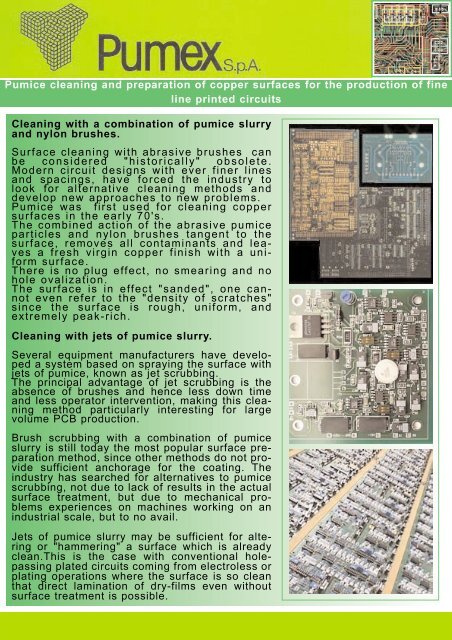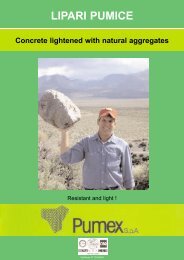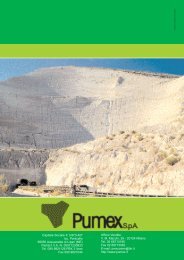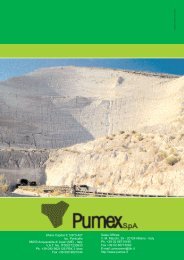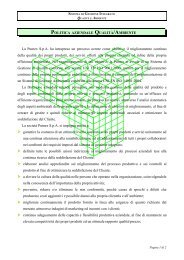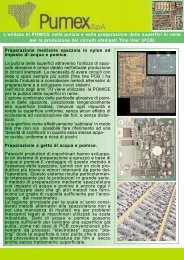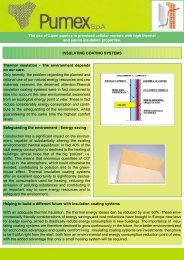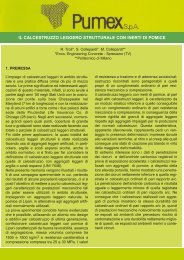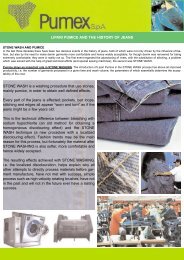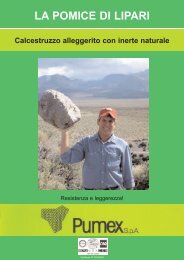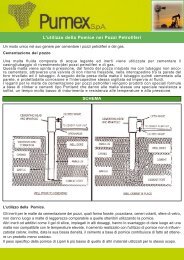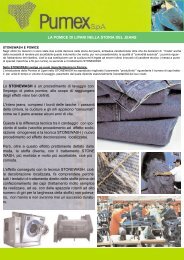Pumice cleaning and preparation of copper surfaces for ... - pumex spa
Pumice cleaning and preparation of copper surfaces for ... - pumex spa
Pumice cleaning and preparation of copper surfaces for ... - pumex spa
Create successful ePaper yourself
Turn your PDF publications into a flip-book with our unique Google optimized e-Paper software.
<strong>Pumice</strong> <strong>cleaning</strong> <strong>and</strong> <strong>preparation</strong> <strong>of</strong> <strong>copper</strong> <strong>surfaces</strong> <strong>for</strong> the production <strong>of</strong> fine<br />
line printed circuits<br />
Cleaning with a combination <strong>of</strong> pumice slurry<br />
<strong>and</strong> nylon brushes.<br />
Surface <strong>cleaning</strong> with abrasive brushes can<br />
be considered "historically" obsolete.<br />
Modern circuit designs with ever finer lines<br />
<strong>and</strong> <strong>spa</strong>cings, have <strong>for</strong>ced the industry to<br />
look <strong>for</strong> alternative <strong>cleaning</strong> methods <strong>and</strong><br />
develop new approaches to new problems.<br />
<strong>Pumice</strong> was first used <strong>for</strong> <strong>cleaning</strong> <strong>copper</strong><br />
<strong>surfaces</strong> in the early 70's.<br />
The combined action <strong>of</strong> the abrasive pumice<br />
particles <strong>and</strong> nylon brushes tangent to the<br />
surface, removes all contaminants <strong>and</strong> leaves<br />
a fresh virgin <strong>copper</strong> finish with a uni<strong>for</strong>m<br />
surface.<br />
There is no plug effect, no smearing <strong>and</strong> no<br />
hole ovalization.<br />
The surface is in effect "s<strong>and</strong>ed", one cannot<br />
even refer to the "density <strong>of</strong> scratches"<br />
since the surface is rough, uni<strong>for</strong>m, <strong>and</strong><br />
extremely peak-rich.<br />
Cleaning with jets <strong>of</strong> pumice slurry.<br />
Several equipment manufacturers have developed<br />
a system based on spraying the surface with<br />
jets <strong>of</strong> pumice, known as jet scrubbing.<br />
The principal advantage <strong>of</strong> jet scrubbing is the<br />
absence <strong>of</strong> brushes <strong>and</strong> hence less down time<br />
<strong>and</strong> less operator intervention, making this <strong>cleaning</strong><br />
method particularly interesting <strong>for</strong> large<br />
volume PCB production.<br />
Brush scrubbing with a combination <strong>of</strong> pumice<br />
slurry is still today the most popular surface <strong>preparation</strong><br />
method, since other methods do not provide<br />
sufficient anchorage <strong>for</strong> the coating. The<br />
industry has searched <strong>for</strong> alternatives to pumice<br />
scrubbing, not due to lack <strong>of</strong> results in the actual<br />
surface treatment, but due to mechanical problems<br />
experiences on machines working on an<br />
industrial scale, but to no avail.<br />
Jets <strong>of</strong> pumice slurry may be sufficient <strong>for</strong> altering<br />
or "hammering" a surface which is already<br />
clean.This is the case with conventional holepassing<br />
plated circuits coming from electroless or<br />
plating operations where the surface is so clean<br />
that direct lamination <strong>of</strong> dry-films even without<br />
surface treatment is possible.
This is not the case with inner layers or<br />
multilayers when the base material<br />
comes directly from the manufacturer<br />
<strong>and</strong> is there<strong>for</strong>e contaminated with grease,<br />
oxide, fingerprints <strong>and</strong> protective<br />
coatings which cannot be removed with<br />
the weak action <strong>of</strong> pumice jets.The<br />
aggressive approach using pumice <strong>and</strong><br />
brushes is necessary to expose a clean,<br />
'virgin' surface, rich with peak points, <strong>for</strong><br />
the best adhesion <strong>of</strong> dry film.<br />
Brush Scrubbing with <strong>Pumice</strong><br />
TYPICAL MACHINE FOR SCRUBBING WITH A PUMICE SUSPENSION AND BRUSHES<br />
THIS SCHEMATIC VERTICAL CROSS SECTION SHOWS<br />
HOW PUMICE IS KEPT INSIDE THE SCRUBBING CHAM-<br />
BER AND ALL RESIDUES ARE WASHED AWAY WELL<br />
BEFORE THEY REACH THE BEARINGS OR THE BRUSH<br />
ROTATION AND ADJUSTMENT MECHANISMS.<br />
Typical convolute roller <strong>for</strong> PCB processing with pumice
A "clever" machine <strong>for</strong> scrubbing all thicknesses <strong>of</strong> <strong>copper</strong>-clad materials<br />
Thin inner layers <strong>of</strong> multilayer, flexible circuits, as well as rigid boards are perfectly cleaned on both sides by means <strong>of</strong> rotating nylon brushes <strong>and</strong> a suspension <strong>of</strong> abrasive <strong>and</strong> water.<br />
The PUMIFLEX-SHD/A is unique in its field thanks to its computerized "CLEVERBRUSH" system.<br />
FEATURES<br />
Patented "CLEVERBRUSH" system which stops the brushes <strong>and</strong>/or starts them in the proper direction <strong>and</strong> at the right time in order to avoid damage to thin foils.<br />
No guides or grids underneath the brushes.<br />
A special transport system with guides supports the foils throughout the rest <strong>of</strong> the machine.<br />
Computer-controlled conveyor rollers automatically ensure the required minimum distance between pieces.<br />
Input conveyor rollers automatically stop when the situation does not correspond to the data preset in the program.<br />
The machine automatically stops when a piece that has entered does not exit in due time.<br />
MAINTENANCE-FREE DESIGN<br />
Built in automatic rinsing system with timers <strong>for</strong> washing all spots where pumice would tend to accumulate or creep out.<br />
Complete separation <strong>of</strong> pumice section from bearings by means <strong>of</strong> an inter<strong>spa</strong>ce 150mm (6") wide.<br />
No gaskets or other protections subject to wear but simple open clearances with spray shields.<br />
One h<strong>and</strong>le only <strong>for</strong> precise simultaneous adjustment <strong>of</strong> all brushes (reading <strong>of</strong> brush height on digital gauge).<br />
Quick brush replacement.<br />
Although originally designed <strong>for</strong> use with pumice, upon request, the machine can be equipped with a reclamation system allowing to operate with other abrasive<br />
powders such as Aluminium Oxide. The difference lies in the fact that pumice is utilized in a closed loop <strong>and</strong> the contaminants removed from the surface are collected<br />
in the slurry tank, whereas Aluminium Oxide can be continuously washed during operation <strong>of</strong> the machine allowing <strong>for</strong> a very long life <strong>of</strong> this type <strong>of</strong> abrasive<br />
slurry.<br />
A "clever" machine <strong>for</strong> scrubbing flexible <strong>and</strong> rigid boards<br />
The PUMIFLEX is the best solution to the problem <strong>of</strong> <strong>cleaning</strong> inner layers <strong>of</strong> multilayers when the base materials come directly from the manufacturer <strong>and</strong> is there<strong>for</strong>e<br />
contaminated with grease, oxide, fingerprints, <strong>and</strong> protective coatings which cannot be removed with the weak action <strong>of</strong> chemicals or jets <strong>of</strong> abrasive<br />
slurry.<br />
No other <strong>cleaning</strong> system <strong>of</strong>fers the aggressive approach with abrasive <strong>and</strong> brushes tangent to the surface which is a must in order to expose a clean, virgin surface,<br />
rich with peak points, <strong>for</strong> best adhesion <strong>of</strong> dry-film.<br />
THE "CLEVERBRUSH" SYSTEM<br />
PUMEX’s products<br />
support the per<strong>for</strong>-<br />
mance <strong>of</strong> the most<br />
modern machinery<br />
<strong>for</strong> PCB <strong>cleaning</strong><br />
PUMEX’s products<br />
support the per<strong>for</strong>mance<br />
<strong>of</strong> the most<br />
modern machinery<br />
<strong>for</strong> PCB <strong>cleaning</strong><br />
The purpose <strong>of</strong> this system is to allow brushing <strong>of</strong> thin materials without damage. The conveyor system consists in pairs <strong>of</strong> pinch rollers <strong>and</strong><br />
guides to support the foils during transportation.<br />
However there are no guides or grids underneath the brushes which would be quickly worn out by the strong combined action <strong>of</strong> nylon brushes <strong>and</strong> abrasive.<br />
The sheets are placed onto the input conveyor one after the other, with their edge parallel to the direction <strong>of</strong> transportation.<br />
A series <strong>of</strong> photocells detects the leading edge <strong>of</strong> sheets <strong>and</strong> the first pair <strong>of</strong> rollers are automatically started <strong>and</strong> stopped in order to provide the necessary <strong>spa</strong>cing<br />
between one sheet <strong>and</strong> the next. An encoder connected to the conveyor drive system constantly monitors the travelling <strong>of</strong> sheets throughout the machine<br />
<strong>and</strong> the signals corresponding to sheet length <strong>and</strong> sheet position are sent to a Programmable Logic Controller (P.L.C.).<br />
Each pair <strong>of</strong> brushes is driven by a self-braking motor which starts <strong>and</strong> stops in the proper direction <strong>and</strong> at the proper time under the control <strong>of</strong> the P.L.C. When<br />
the leading edge <strong>of</strong> a thin foil reaches the brushes, these rotate in the direction <strong>of</strong> transportation so that the foil is conveyed between them.<br />
The action (=friction) <strong>of</strong> the brushes in the direction <strong>of</strong> transportation would damage very thin foils, as soon as their trailing edge leaves the pinch rollers be<strong>for</strong>e<br />
the brushes. There<strong>for</strong>e, be<strong>for</strong>e this happens, brushes stop <strong>and</strong> immediately reverse the direction <strong>of</strong> rotation. In this way the sheet is always under pull by the<br />
brushes themselves.<br />
After the trailing edge leaves the brushes, these reverse once more, ready to process the next piece.<br />
All above steps are repeated in the same manner <strong>for</strong> each board, upon reaching each <strong>of</strong> the three pairs <strong>of</strong> brushes.<br />
The inversion <strong>of</strong> rotation <strong>of</strong> each one <strong>of</strong> the three pairs <strong>of</strong> brushes takes place in three different positions along the same board in order to avoid non-uni<strong>for</strong>m<br />
scrubbing.


